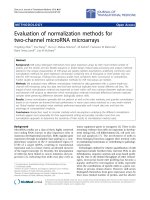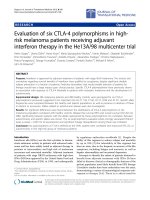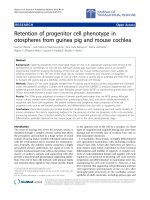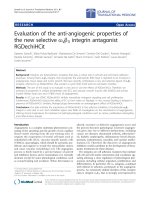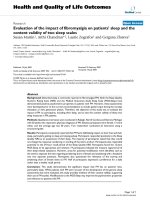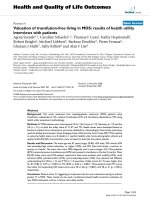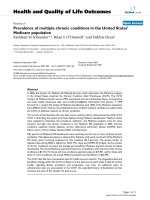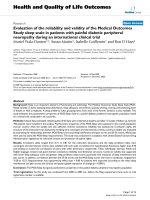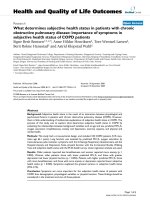báo cáo hóa học:" Evaluation of early atherosclerotic findings in women with polycystic ovary syndrome" docx
Bạn đang xem bản rút gọn của tài liệu. Xem và tải ngay bản đầy đủ của tài liệu tại đây (240.63 KB, 5 trang )
RESEARCH Open Access
Evaluation of early atherosclerotic findings in
women with polycystic ovary syndrome
Afshin Mohammadi
1*
, Mohammadreza Aghasi
2
, Leila Jodeiry-farshbaf
3
, Shaker Salary-Lac
4
and
Mohammad Ghasemi-rad
5
Background: Polycystic ovary syndrome (PCOS) is the most common endocrinopathy in women of childbearing
age, and it seems better to consider it as an ovarian manifestation of metabolic syndrome. The aim of the current
study was to evaluate early atherosclerotic findings in patients with PCOS.
Methods: We enrolled 46 women with PCOS and 45 normal control subjects who were referred to our hospital’s
endocrinology outpatient clinic. Carotid intima media thickness (CIMT) and flow-mediated dilatation (FMD) were
performed in both cases and matched controls.
Results: Patients with PCOS showed an increased mean CIMT (0.63 ± 0.16 mm) when compared with the control
subjects (0.33 ± 0.06 mm). This difference was statistically significant (p = 0.001). The mean FMD in young patients
with PCOS was 10.07 ± 1.2%, while it was 6.5 ± 2.06% in normal subjects. This difference was also statistically
significant (p = 0.001).
Conclusion: Our findings suggest that PCOS is related with early atherosclerotic findings.
Background
Polycystic ovary syndrome (PCOS) is the most common
endocrinopathy in women of childbearing age, and it
seems better to consider it as an ovarian manifestation of
metabolic syndrome (MS) [1,2]. MS has already been con-
firmed as part of the tsunami of cardiovascular risk factors
(obesity, lipid abnormalities, impaired glucose tolerance
and hypertension) [3]. Insulin resistance is considered as
the basic pathophysiological mechanism in MS, and is also
a w ell-recognised presentation of PCOS [4]. However,
data regarding endothelial function impairment as an indi-
cator of increased risk of cardiovas cular disease in PCOS
are still controversial [5,6], with some studies saying that
PCOS-induced insulin resistance does not show endothe-
lial dysfunction [7]. The aim of our study was to assess
and compar e the end othelial function as a predicto r of
cardiovascular risk by measuring flow-mediated dilatation
in young women with PCOS and matched control
subjects.
Method
Before the beginning of the study, its protocol was
approved by the University Ethics Committee and the
Faculty of M edicine. Writt en informed c onsent was
obtained from each participant. We enrolled 46 women
with PCOS and 45 normal control subjects who were
referred to our hospital’s endocrinology outpatient clinic.
The patients and controls were selected from the normo-
tensive population with a body mass index (BMI) less
than 27 kg/m
2
. Women with diabetes mellitus, cases of
hypertension and those with age above 30 years and BMI
above 27 kg/m
2
were excluded from study.
The diagnosis of PCOS was documented based on a his-
tory of oligomenorrhoea or amenorrhoea (less than eight
cycles per year), clinical or biochemical manifestations of
hyperandrogenism such as hirsutism, acne or elevation of
at least one circulating ovarian androgen (serum dehy-
droepiandrosterone sulphate [DHEAS] or testosterone)
and polycystic ovaries at ultrasound. Two of three criteria
were su fficient to confirm the dia gnosis. Controls we re
healthy women with normal menstrual cycles, non-hyper-
androgenic, non-hirsute and with normal ovarian mor-
phology at ultrasound. One examiner (M.A.) assessed the
* Correspondence:
1
Department of Radiology, Urmia University of Medical Sciences, Urmia, Iran
Full list of author information is available at the end of the article
Mohammadi et al. Journal of Ovarian Research 2011, 4:19
/>© 2011 Mohammadi et al; licensee BioMed Centr al Ltd. This is an Open Access article distributed under the terms of the Creative
Commons Attribution License ( which pe rmits unrestricted use, distribution, and
reproduction in any medium, provided the original work is properly cited.
hirsutism according to Ferriman-Gallwey score; a score
greater than 7 was considered to indicate hirsutism.
All those with secondary causes of hyperandrogenism,
such as hyperprolactinaemia, thyroid disease, late onset
congen ital adrenal hyperplasia (17-OH progesterone > 2
ng/dl), androgenic tumour (testosterone > 4 ng/ml), Cush-
ing disease, renal or liver failure, pregnancy and diabetes
mellitus, were excluded from the study. After basic history
taking, anthro pometric properties o f cases and controls
such as BMI, waist circumference (WC), hip circumfer-
ence (HC), ratio of WC/HC and systolic and diastolic
blood pressure were measured.
Fasting blood samples were collected for measurement
of blood glucose, insulin, androgens, triglycerides (TG),
total cholesterol (TC), high-density lipoprotein (HDL) and
low-density lipoprotein (LDL). Insulin resistance (IR) was
assessed using both fasting insulin levels and the homeos-
tasis model assessment (HOMA) calculation: fasting
serum insulin (micro units per millilitre) multiplied by
fasting plasma glucose (millimoles per litre) and divided
by 22.5.
The serum levels of DHEAS, follicle-stimulating hor-
mone (FSH), luteinising hormone (LH), 17 hydroxy
(OH) progesterone, testosterone and prolactin were also
measured in cases and controls.
CIMT measurement
High-resolution B mode ultrasonographies of both the
common and internal carotid arteries were performed
with an ultrasound device (Siemens, Sonoline G40,
Germany) equipped with a 10 MHz linear arra y transdu-
cer. Patient s were examined in the supine posit ion w ith
the head tilted backwards. After the carotid ar teries were
located by transverse scan, the probe was rotated 90° to
obtain and record a longitudinal image of common carotid
arteries.
The maximum CIMT was measured at the posterior
wall of the common carotid artery, 2 cm before the bifur-
cation, as the distance between first and second echogenic
lines of anterior and posterior arterial walls. The image
was focused on the posterior wall of the common carotid
artery, and we used the gain settings to optimise the qual-
ity of the image. For accuracy, the CIMT measurements
were performed vertical to the arterial wall. Three CIMT
measurements were taken at each site and the average
measurement was calculated and used.
Flow-mediated dilatation (FMD) measurement
Ultrasound examination of FMD was performed in the
morning after overnight fast, after 15 minutes re st in the
horizontal position, by means of a Sonoline G40 ultra-
sound scanner (Siemens, Germany) with a linear transdu-
cer (10 MHz). The d iameter o f the right brachial artery
was measured 3-5 cm above the antecubital space at
baseline. The measurement was performed in the end-
diastolic phase, marking the diameter between anterior
and posterior artery wall in the zone between the me dia
and adventitia (’m-line’). An average of three measure-
ments was taken and furth er analysed to calculate FM D.
Subsequently, a pneumatic tourniquet was placed on the
upper part of the right forearm and inflated for four min-
utes to a pressure of 200 mm Hg or 50 mm Hg above sys-
temic arterial blood pressure. Sixty seconds after cuff
release, the diameter of the right brachial artery was mea-
sured three times. FMD was calculated as an increase of
vascular diameter (in percentage) from the difference
between maximum and baseline brachial artery diameter.
Data were calculated as absolute diame ter of the brachial
artery (in mm) and percentage increased in the diameter
of the brachial artery. CIMT and FMD in all cases and
controls were measured by one radiologist (A.M.), who
was blinded to clinical and laboratory data of patients and
controls.
Statistical analysis was performed using SPSS (version
16. Chicago, IL, USA). We performed the statistical calcu-
lation by using the T-test, Mann-Whitney U test, Kolmo-
gorov-Smirnov (K-S) test and logistic regression. A p value
equal or less than 0.05 was considered statistically
significant.
Results
The mean ± SD of age was 23.02 ± 5.17 in t he patient
group and 27.96 ± 3.97 in the control group. The mean ±
SD of BMI in PCOS was 25.08 ± 5.54 kg/m
2
, and in co n-
trol subjects it was 21.59 ± 3.08 kg/m
2
. There were statisti-
cally significant differences in age, BMI, AC, HC and ratio
of AC/HC between cases and control subjects. Table 1
summarises the anthropometrics data of PCOS and con-
trol subjects.
Table 1 This table shows the anthropometric data of the
cases and controls
Variable Group Number Mean ± SD P value
Age Control 45 27.96 ± 3.97 0.000
PCOS 46 23.02 ± 5.17
Height Control 45 163.78 ± 3.80 0.03
PCOS 46 161.43 ± 6.40
Weight Control 45 58.73 ± 7.44 0.008
PCOS 46 65.60 ± 15.25
BMI Control 45 21.59 ± 3.80 0.001
PCOS 46 25.80 ± 5.45
AC Control 45 80.16 ± 12.76 0.65
PCOS 46 81.61 ± 12.86
HC Control 45 97.87 ± 6.20 0.003
PCOS 46 105.96 ± 16.46
WC/HC Control 45 0.82 ± 0.4 0.02
PCOS 46 0.79 ± 0.09
Mohammadi et al. Journal of Ovarian Research 2011, 4:19
/>Page 2 of 5
The mean systolic blood pressure (SBP) and diastolic
bloo d pressure (DBP) in PCOS patients and control sub-
jects were 114.46 ± 29.02 mm/Hg, 79.02 ± 8.40 mm/Hg
and 120.67 ± 18.26 mm/Hg, 78.40 ± 7.37 mm/Hg, respec-
tively. There was no statistically significant difference
between PCOS and controls in terms of SBP and DBP.
There were statistically significant differences in te rms of
FBS, TG, TC, LDL and HDL between PCOS an d control
subjects. Table 2 summarises the SBP, DBP and biochem-
ical data of PCOS patients and control subjects.
Assessment of sex hormone and insulin levels between
PCOS and control subjects showed that there was a signif-
icant difference in term of FSH, prolactin (PRL), testoster-
one and DHEAS b etween cases and controls, but there
were no significant differences between cases and controls
in term of LH and 17 OH progesterone levels. Table 3
summarises the serum insulin and sex hormone levels in
PCOS patients and controls.
Patients with PCOS demonstrated higher HOMA index
levels of (2.77 ± 1.80 vs. 0.81 ± 0.08; p < 0.000) when com-
pared with the control subjects. Furthermore, patients
with PCOS showed an increased mean CIMT (0.63 ± 0.16
mm) when compared with the control s ubjects ( 0.33 ±
0.06 mm). This difference was statistically significant
(p = 0.001).
The mean ± SD of brachial artery diameter at baseline
was 3.89 ± 0. 19 mm in normal subjects and 3.86 ± 0.11
mm in the PCOS group. The difference was not statisti-
cally significant (p = 0.19). Moreover, the mean ± SD of
brachial artery diameter post ische mia was 4.13 ± 0.17
mm in normal subjects and 4.23 ± 0.12 mm in the
PCOS group. The difference was statistically significant
(p = 0.01).
The mean FMD in young patients with PCOS was
10.07 ± 1.2% and 6.5 ± 2.06% in normal subjects. The dif-
ference was statistically significant (p = 0.001). On the
other hand, there was no significant association between
HOMA index and CIMT in PCOS patients (r = +0.13;
p = 0.18). The HOMA index of insulin resistance had a
significantly negative relation with FMD in PCOS
patients (r = -0.3; p = 0.02).
Discussion
The endothelium is considered the largest endocrine
gland, and secretes many transmitters to maintain the
homeostasis of the circulatory system [8]. FMD is a non-
invasive US method currently recognised as a useful
technique for the evaluation of endothelial function [8].
The basic mechanism of FMD is the evaluation of b ra-
chial artery dilatation by evoking brachial artery ischemia.
After brachial artery occlusion, endo thelial nitric oxide is
released and vascular smooth muscle relaxation occurs
[9].
One of the early processes in the pathophysiology of
atherosclerosis is impaired endothelial function [10].
Impaired endothelial function which is quantified by FMD
is a marker of increased cardiovascular risk because it is
well correlated with impaired endothelial function in cor-
onary arteries [11]. The exact effect of PCOS on endothe-
lial function remains controversial. Several studies have
revealed that it is not impaired in women with PCOS who
are either not obese or do not display morbid obesity
[7,12,13]. However, some authors believe that endothelial
function is impaired in patients with PCOS [5,14,15]. In
our investigation, we evaluated vascular function in sub-
jects with PCOS, and compared those patients with
healthy control subjects.
Our study demonstrates a significant difference in CIMT
between both age-matched PCOS and control subjects.
Our result is in agreement with the report by Lukhani [16]
and Talbott et al. [17] but is in contrast with the study of
the Meyer et al. [4]. Our study demonstrates a significant
difference in FMD between both PCOS and control
groups, which is in agreement [9,18] and in contrast
[7,19-22] with other studies. Orio et al showed that a
significant difference in flow-mediated dilation and in
intima -media thickn ess in young, normal-we ight, nondy-
slipidemic, nonhypertensive women with PCOS in com-
parison with control subjects [14]. Although they excluded
patients with dyslipidemia and hypertension from study
group but our results are in concordance to the report by
them.
Our results provide additional evidence confirming
that there is endothelial dysfunction in women with
PCOS in comparison with normal subjects.
The pathophysiological mechanism of inducing
endothelial dysfunction remains unclear, but insulin
resistance seems to b e essential. Beckman et al. [7]
reported an association between insulin resistance and
endothelial dysfunction in type 2 DM and lipodystrophic
diabetes. Others have shown an association between
insulin resistance in children with DM and MS [23,24].
Table 2 This table shows the systolic and diastolic blood
pressure and biochemical data of the cases and controls
SBP (mm/Hg) Controls 45 120.67 ± 18.26 0.22
Cases 46 114.46 ± 29.02
DBP (mm/Hg) Controls 45 78.44 ± 7.37 0.72
Cases 46 79.02 ± 8.40
FBS (mg/dl) Controls 45 74.73 ± 9.28 0.0001
Cases 46 85 ± 8.67
TG (mg/dl) Controls 45 98.76 ± 48.90 0.04
Cases 46 123.02 ± 62.70
LDL (mg/dl) Controls 45 118.79 ± 31.76 0.05
Cases 46 133.43 ± 40.24
HDL (mg/dl) Controls 45 60.16 ± 13.16 0.0001
Cases 46 47.49 ± 8.41
Mohammadi et al. Journal of Ovarian Research 2011, 4:19
/>Page 3 of 5
The postulated mechanisms whereby insulin resistance
can adversely affect the endothelium are: overproduction
of free fatty acids; tumour necrosis factor (TNF) a; lep-
tin, w hich causes endothelial dysfunction; and the
induction of an increased oxidative stress mechanism
that, contributes to endothelial dysfunction [4,25,26].
In our study, there was a statistically significant differ-
ence in terms of BMI between PCOS and control sub-
jects (both groups had normal BMI but the difference
between them was statistically significant). Previous stu-
dies reported that the endothelial function was preserved
in lean individuals and without morbid obesity with
PCOS [8,13], but this still remains controversial [6,14,15].
We accept the lack of BMI matching as a limitation of
our study, and recommend its consideration in future
research.
Although in our study, the mean CIMT was different
between PCOS and normal subjects, the HOMA index
was corre lated with FMD and we did not find a relation-
ship be tween t he HOMA index and CIMT. A previous
study revealed that endothelial dysfunction occurred
early in the development of atherosclerosis, preceding
the onset of increased CIMT [27]. Thus, it seems that
various risk factors in PCOS patients may contribute
separately to the development of endothelial dysfunction.
We found that young patients with PCOS had higher
levels of MS inclusion criteria such as serum TG, TC,
LDL, FBS, insulin, insulin resistance (HOMA-IR) and
lowe r levels of serum HDL. Thus, we be lieve it is better
to consider PCOS as an ovarian manifestation of MS.
In conclusion, PCOS accompanies the tsunami of MS
and hormonal abnormalities such as i nsulin resistanc e,
dyslipidaemia, hyperandrogenaemia all make PCOS
patients susceptible to future cardiovascular events. The
diagnosis of this entity may offer an early cardio-protective
protocol for women with PCOS.
List of abbreviations
PCOS: Polycystic ovary syndrome; Met S: Metabolic syndrome; TG:
Triglyceride; CIMT: carotid intima media thickness; TC: Total cholesterol; LDL:
Low density lipoprotein; HDL: High density lipoprotein; IR: Insulin Resistance;
FMD: Flow-mediated dilatation.
Acknowledgements
This research was supported by a grant from Urmia University of Medical
Sciences
Author deta ils
1
Department of Radiology, Urmia University of Medical Sciences, Urmia, Iran.
2
Department of Endocrinology, Urmia University of Medical Sciences, Urmia,
Iran.
3
Department of Internal Medicine, Urmia University of Medical Sciences,
Urmia, Iran.
4
Department of public health, Urmia University of Medical
Sciences, Urmia, Iran.
5
Student research committee, Urmia University of
Medical Sciences, Urmia, Iran.
Authors’ contributions
All the authors in this manuscript have read and approve the final manuscript.
MA: concept and design, and manuscript writing. AM: The Ultrasonographic
studies and manuscript writing. MG: Data collection, Manuscript editing. LJ:
Data Collection, concept and design. SS: Data analysis.
Competing interests
The authors declare that they have no competing interests.
Received: 30 September 2011 Accepted: 24 October 2011
Published: 24 October 2011
References
1. Baranova A, Tran TP, Birerdinc A, Younossi ZM: Systematic review:
association of polycystic ovary syndrome with metabolic syndrome and
non-alcoholic fatty liver disease. Aliment Pharmacol Ther 2011,
33(7):801-14.
2. Ovalle F, Azziz R: Insulin resistance, polycystic ovary syndrome and type
2 diabetes. Fertil Steril 2002, 77:1095-1105.
3. Mohammadi A, Ghasemi-rad M, Zahedi H, Toldi G, Alinia T: Effect of
severity of steatosis as assessed ultrasonographically on hepatic vascular
indices in non-alcoholic fatty liver disease. Medical Ultrasonography 2011,
13(3):200-206.
4. Meyer C, McGrath BP, Teede HJ: Overweight women with polycystic ovary
syndrome have evidence of subclinical cardiovascular disease. J Clin
Endocrinol Metab 2005, 90(10):5711-6.
5. Wenner MM, Taylor HS, Stachenfeld N: ET-B receptor contribution to
peripheral microvascular functions in women with Polycystic Ovary
Syndrome. J Physiol 2011, 8.
Table 3 This table shows the serum hormonal characteristics of the cases and controls
Variable Groups Number Mean ± SD P Value
FSH (mIu/ml) Controls 45 5.57 ± 1.88 0.01
Cases 46 7.33 ± 4.25
LH (mIu/ml) Controls 45 5.46 ± 4.72 0.24
Cases 46 26.51 ± 14.63
PRL (ng/ml) Controls 45 13.61 ± 5.39 0.001
Cases 46 21.15 ± 19.11
Testosterone Controls 45 0.55 ± 0.87 0.001
Cases 46 1.58 ± 1.21
DHEAS (g/dl μ) Controls 45 187.22 ± 105.61 0.001
Cases 46 284.48 ± 111.18
17(OH) Progesterone (ng/dl) Controls 45 1.25 ± 0.76 0.23
Cases 46 1.69 ± 2.35
Insulin (mIu/ml) Controls 45 4.34 ± 1.90 0.001
Cases 46 12.62 ± 8.13
Mohammadi et al. Journal of Ovarian Research 2011, 4:19
/>Page 4 of 5
6. Tarkun I, Arslan BC, Cantürk Z, Türemen E, Sahin T, Duman C: Endothelial
dysfunction in young women with polycystic ovary syndrome:
relationship with insulin resistance and low-grade chronic inflammation.
Journal of Clinical Endocrinology and Metabolism 2004, 89:5592-5596.
7. Beckman JA, Goldfine AB, Dunaif A, Gerhard-Herman M, Creager MA:
Endothelial function varies according to insulin resistance disease type.
Diabetes Care 2007, 30(5):1226-32.
8. The Rotterdam ESHRE/ASRM-Sponsored PCOS Consensus Workshop Group:
Revised 2003 consensus on diagnostic criteria and long-term health
risks related to polycystic ovary syndrome. Fertil Steril 2004, 81:19-24.
9. Kaźmierski M, Michalewska-Włudarczyk A, Krzych LJ, Tendera M: Diagnostic
value of flow mediated dilatation measurement for coronary artery
lesions in men under 45 years of age. Cardiol J 2010, 17(3):288-92.
10. . Tschakovsky ME, Pyke KE: Counterpoint: Flow-mediated dilation does
not reflect nitric oxide-mediated endothelial function. J Appl Physiol 2005,
99(3):1235-8.
11. Asselbergs FW, Van der harst P, Jessurum GA, Tio RA, Van Glist WH: Clinical
impact of vasomotor function assessment and the role of ACE-inhibitors
and statins. Vascul Pharmacol 2005, 42(3):125-40.
12. Peretz A, Leota DF, Sullivan JH, Trenga CA, Sands FN, Aulet MR, Paun M,
Gill EA, Kaufman JD: Flow mediated dilation of the brachial artery: an
investigation of methods requiring further standardization. BMC
Cardiovascular Disorder 2007, 7:11.
13. Mather K, Anderson TJ, Verma S: Insulin action in the vasculature:
physiology and pathophysiology. J Vasc Res 2001, 38:415-422.
14. Orio F Jr, Palomba S, Cascella T, De Simone B, Di Biase S, Russo T, Labella D,
Zullo F, Lombardi G, Colao A: Early impairment of endothelial structure
and function in young normal-weight women with polycystic ovary
syndrome. J Clin Endocrinol Metab 2004, 89:4588-4593.
15. Kravariti M, Naka KK, Kalantaridou SN, Kazakos N, Katsouras CS,
Makrigiannakis A, Paraskevaidis EA, Chrousos GP, Tsatsoulis A, Michalis LK:
Predictors of endothelial dysfunction in young women with polycystic
ovary syndrome. J Clin Endocrinol Metab 2005, 90:5088-5095.
16. Paradisi G, Steinberg HO, Hempfling A, Cronin J, Hook G, Shepard MK,
Baron AD: Polycystic ovary syndrome is associated with endothelial
dysfunction. Circulation 2001, 103:1410-1415.
17. Lakhani K, Hardiman P, Seifalian A: Intima-media thickness of elastic and
muscular arteries in young women with polycystic ovaries. Atherosclerosis
2004, 175:353-359.
18. Talbott E, Guzick D, Sutton-Tyrrell K, McHugh-Pemu P, Zborowski J,
Remsberg K: Evidence for the association between polycystic ovary
syndrome and premature carotid atherosclerosis in middle aged
women. Arterioscler Thromb Vasc Biol 2000, 20:2414-2421.
19. Paradisi G, Steinberg H, Hempfling A, Cronin J, Hook G, Shepard M:
Polycystic ovarian syndrome is associated with endothelial dysfunction.
Circulation 2001, 103:1410-1415.
20. Mather KJ, Verma S, Corenblum B, Anderson TJ: Normal endothelial
function despite insulin resistance in healthy women with the polycystic
ovary syndrome. J Clin Endocrinol Metab 2000, 85:1851-1856.
21. Brinkworth GD, Noakes M, Moran LJ, Norman R, Clifton PM: Flow-mediated
dilatation in overweight and obese women with polycystic ovary
syndrome. BJOG 2006, 113(11):1308-1314.
22. Jonard S, Robert Y, Cortet-Rudelli C, Pigny P, Decanter C, Dewwailly D:
Ultrasound examination of polycystic ovaries: is it worth counting the
follicles? Hum Reprod 2003, 18(3):598-603.
23. Ehrmann DA: Polycystic ovary sybdrome. N Engl J Med 2005,
352(12):1223-1236.
24. Quinones M, Pampaloni M, Juarez B: Insulin resistance in healthy Mexican
Americans is associated with coronary artery endothelial dysfunction.
Diabetes 2000, 49:A146.
25. Balletshofer B, Rittig K, Enderle M: Endothelial dysfunction is detectable in
young normotensive first degree relatives of subjects with type II
diabetes in association with insulin resistance. Circulation 2000,
101:1780-1784.
26. Arcaro G, Cretti A, Balzano S, Lechi A, Muggeo M, Bonora E: Insulin causes
endothelial dysfunction in humans. Circulation 2002, 105:576-585.
27. Singh T, Groehn H, Kazmers A: Vascular function and carotid intimal-
medial thickness in children with insulin-dependent diabetes mellitus. J
Am Coll Cardiol 2000, 19:661-665.
doi:10.1186/1757-2215-4-19
Cite this article as: Mohammadi et al.: Evaluation of early atherosclerotic
findings in women with polycystic ovary syndrome. Journal of Ovarian
Research 2011 4:19.
Submit your next manuscript to BioMed Central
and take full advantage of:
• Convenient online submission
• Thorough peer review
• No space constraints or color figure charges
• Immediate publication on acceptance
• Inclusion in PubMed, CAS, Scopus and Google Scholar
• Research which is freely available for redistribution
Submit your manuscript at
www.biomedcentral.com/submit
Mohammadi et al. Journal of Ovarian Research 2011, 4:19
/>Page 5 of 5
